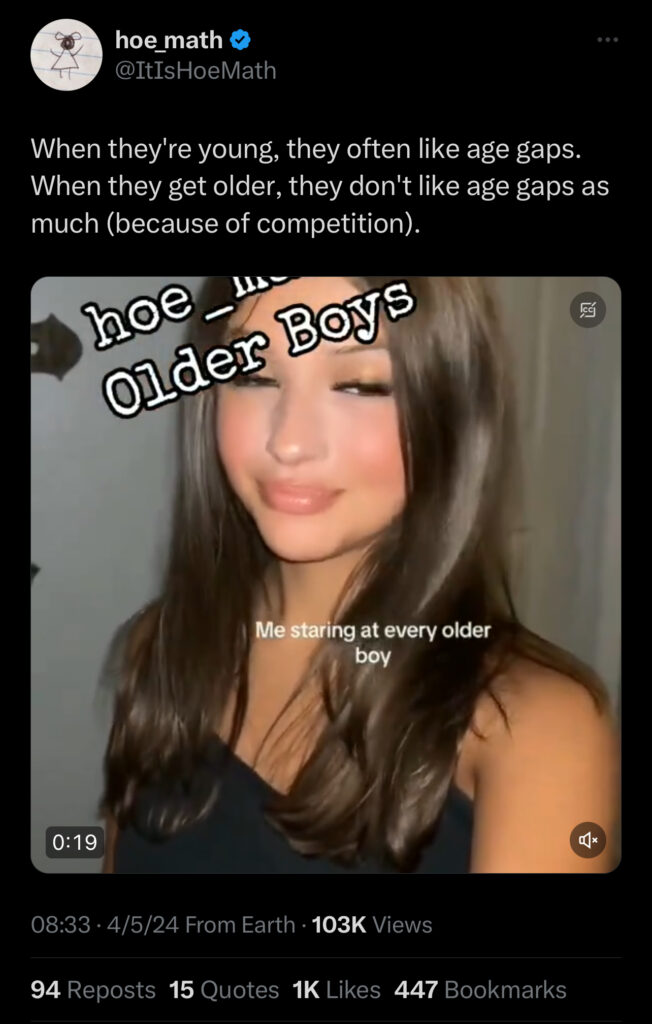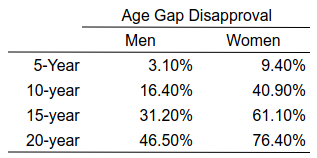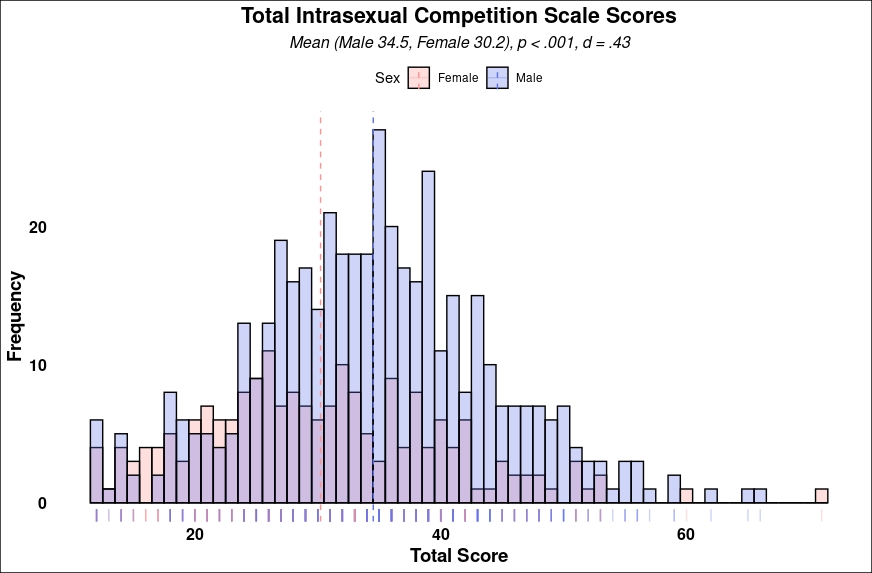Enjoy DatePsychology? Consider subscribing at Patreon to support the project.
In March of 2023, a little over one year ago, I collected data on age gap relationships, or romantic relationships with a substantial age difference between the partners involved (see: Age Gaps & Hierarchical Relationships). One hypothesis I wanted to explore was the association between participant age and approval of age gap relationships. If age gap relationships pull older men from the mating pool then we might expect older women to show lower approval of age gap relationships. This could represent a form of intrasexual competition, or a social competition for access to mating opportunities. By showing social disapproval for age gap relationships, or by shaming participants of age gap relationships, the formation of age gap relationships could be discouraged, thus freeing up same-aged men.
However, for women I found a null result: there was no difference in the approval of age gap relationships across female age groups. Interestingly, in the case of men, older men approved more of age gap relationships than younger men. Young men might adopt beliefs against age gap relationships as a form of intrasexual competition. Intrasexual competition is not the only explanation here, but the age difference in approval is necessary to support that hypothesis.
The hypothesis that older women approve less of age gap relationships is also something that a lot of people have come up with on their own. It’s simply a very intuitive guess. Truly, it isn’t a bad hypothesis at all.
Unfortunately, a lot of people also tend to believe their own intuitions are facts. Making the cognitive leap from “it feels right to me” to “it is objectively true” is quite common. A strong belief in one’s own correctness is all it takes for some people to confidently assert that their best guess is empirically true.
Below is a post from popular TikToker hoe_math. Hoe_math is an anonymous social media influencer who draws cartoons about relationship dynamics. Despite his name, hoe_math almost never uses real data (or math) when producing his cartoons. However, hoe_math does produce very entertaining infographics and diagrams nonetheless, ostensibly based on how he feels things to be.

Here we have the intrasexual competition hypothesis as folk psychology, although stated as if it were a fact. This post also reminded me that it had been a little over a year since the last time I tested this hypothesis. In other words, it was time to test it again,
Methods
N = 655 (31% Female) participants were recruited from a social media convenience sample. Participant sex, age, and sexual orientation was collected. Four short items were presented representing 5, 10, 15, and 20-year age gaps. (Example item: “A 20-year-old woman is in a romantic relationship with a 25-year-old man.”) Participants were instructed to rate how much they approved of the age gap in each item on a 7-point Likert scale. To measure individual differences in intrasexual competition, participants also completed the Intrasexual Competition Scale (Buunk & Fisher, 2009).
Data analysis was performed in R. Bivariate Pearson’s correlations were used to assess the relationships between age and age gap approval, as well as between intrasexual competition scale scores and age gap approval. Age gap approval scores were summed across the four age gap ranges to create a total score. Age gap approval scores were also summed for 15 and 20-year age gaps only to create a large age gap approval score. T-tests were used for comparisons of groups (e.g. male and female). The pwr package was used to determine the minimum sample needed for a medium-sized bivariate correlation (.3; N = 84). The final female subsample (N = 203) allowed for detecting a correlation of .2 with a power of 80%.
No participants failed attention checks nor tests for erroneous answers. 10 participants indicated consistently low responses on the Intrasexual Competition Scale and were removed for a comparison analysis, which indicated that their responses did not shift the statistical significance of any correlations nor effect size beyond < .03. As these participants did not show erroneous answers elsewhere they were included in the final analysis.
Results
Descriptive Statistics
The average age for men was 30.8 (SD 9.8) and for women was 34.7 (SD 11.6). Image 1 shows the age distribution for men and women. 83.5% of the sample was heterosexual, 14.2% was bisexual, and 2.3% was gay or lesbian.

Sex Differences in Age Gap Approval
Images 2-5 show the approval of 5, 10, 15, and 20-year age gaps for men and women. Differences between men and women were significant for every age gap at p < .001 (Cohen’s d was .42, .67, .70, and .78 for 5, 10, 15, and 20-year age gaps respectively).




Table 1 shows the percentage of men and women who disapproved (scores of 3 and below) of the age gap.

Sex Differences in Intrasexual Competition
Image 6 shows sex differences in scores on the Intrasexual Competition Scale (Buunk & Fisher, 2009). A significant difference was found between the mean total scores for male (M = 34.5) and female (M = 30.2) participants (t(372.16) = 5.10, p < .001, d = 0.43).

Hypothesis 1: Participant Age and Age Gap Approval
For men, a significant positive correlation was observed between age and total age gap approval (r = .25, p < .001, 95% CI [.16, .33]). A positive correlation between age and approval of large age gaps for men (r = .26, p < .001, 95% CI [.17, .34]).
For women, there was no significant correlation between age and total age gap approval (r = .03, p = .719, 95% CI [-.11, .16]) nor for age and approval of large age gaps (r = -.01, p = .849, 95% CI [-.15, .12]).
Hypothesis 2: Intrasexual Competition and Age Gap Approval
For both men and women, there were no significant correlations found between intrasexual competition scores and total age gap approval (Men, r = -.03, p = .559, 95% CI [-.12, .06]; women, r = .05, p = .446, 95% CI [-.08, .19]). There were also no significant correlations found between intrasexual competition scores and approval of large age gaps (Men, r = -.03, p = .49, 95% CI [-.12, .06]; women, r = .06, p = .385, 95% CI [-.08, .20]).
Discussion
Replicating past year’s results, more positive views of large age gaps were held by older men on average, while there was no relationship between age and the approval of age gap relationships for women. Intrasexual competition was also unrelated to the approval of age gaps for men and for women.
Women viewed age gap relationships less positively than men did at all ranges. 5-year age gaps were viewed positively by most people, but large sex differences emerged for age gaps of 10-years or above.
In short, older women don’t view age gaps more negatively than younger women do. Women simply view large age gaps (with young women) negatively across the board, irrespective of their own age.
References
Buunk, A. P., & Fisher, M. (2009). Individual differences in intrasexual competition. Journal of Evolutionary Psychology, 7(1), 37-48.
5 comments
Do women also disapprove large age gaps when the man is younger than the woman? (‘Toyboy’)
This is a surprising result. I certainly believed older women would have disapproved more for competitive reasons. It would be good to see a replication, but to be fair and reasonable I need to update my opinion.
Any hypotheses for why women of all ages are so much more disapproving?
Listen to what women do, not what they say. Of course younger women are going to say they don’t approve of older men on a survey.
“Listen to what women do, not what they say”
Average age gap for married people for in United States: 2 Years.
Women are marrying men 2 years older at best.
Keep coping
There’s some other studies that show the young generation are harsher critics about this or that people are more judgmental about older men and younger women than vice versa nowadays (unlike back in the day). I do think woke people or feminists tend to be harsher critics about older men and younger women dating, as they go out of their way to complain about it more.
But I also think it’s common among zoomers, and a lot of zoomers do complain about age gaps between young adults. Maybe not 20 and 25 but certainly 18-19 and 25.
https://www.toddkshackelford.com/downloads/Sela%20et%20al-PAID-2018.pdf
https://link.springer.com/article/10.1007/s12144-018-9895-6